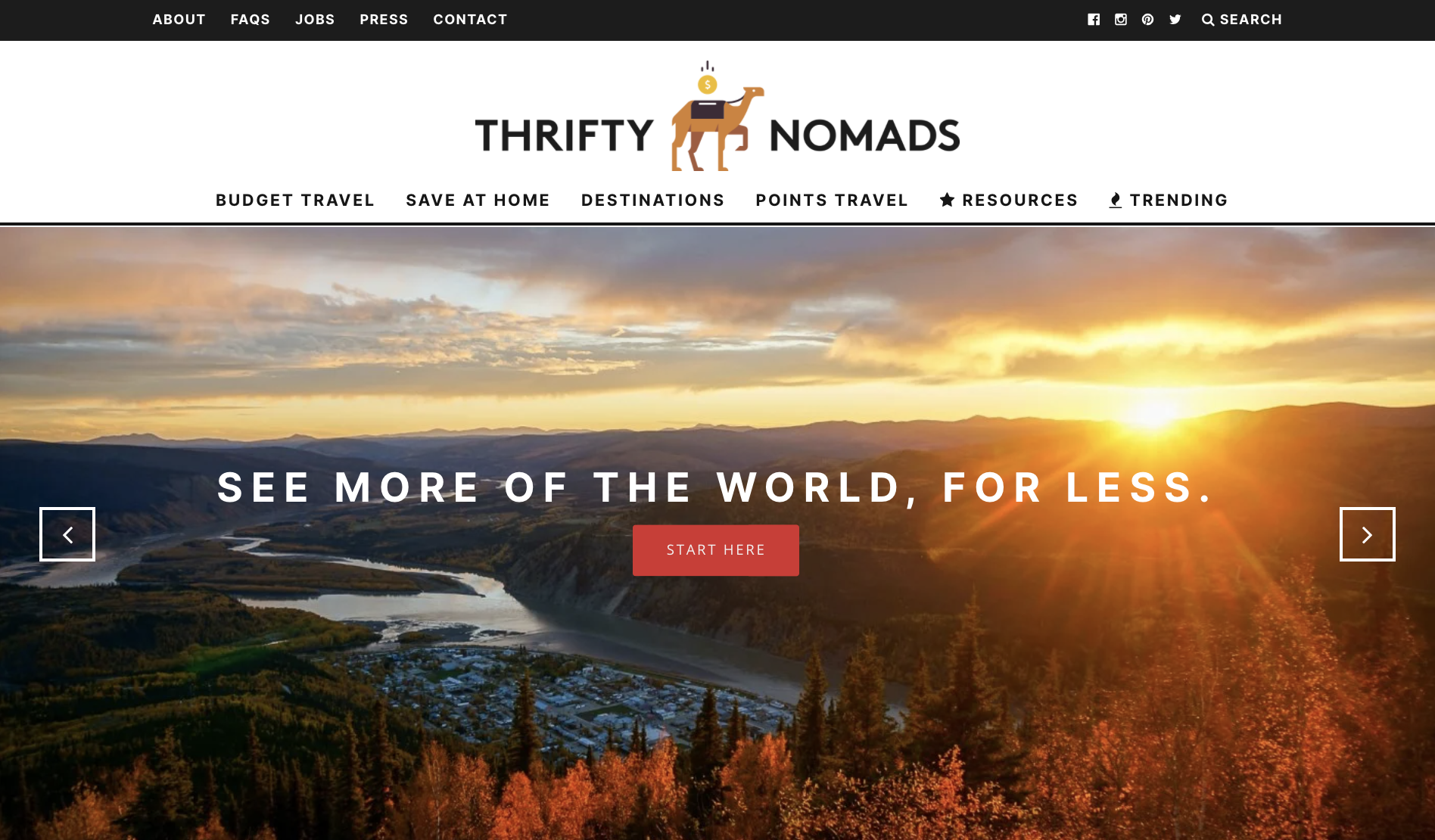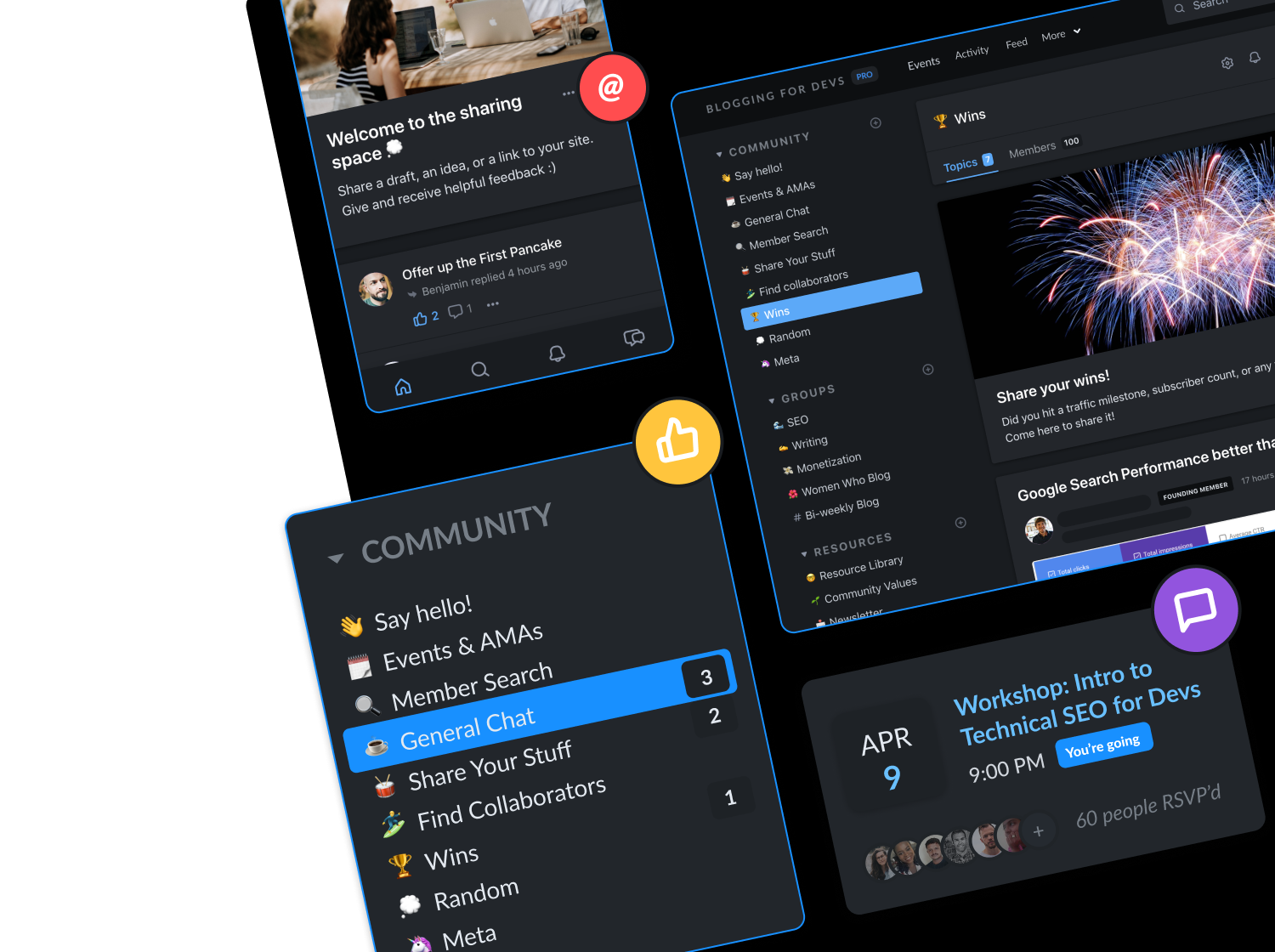Decoupling Your Time From Your Money Through Blogging with Ted Avery

Monica Lent published
Hey everyone! It's time for another interview, and today I'm super stoked to be talking with Ted Avery from Thrifty Nomads.
I first got to know Ted as a prospective customer for Affilimate, but soon learned that he also had a software development background despite being a full-time blogger.
Whenever someone with technical skills decides to go down a different career path, I'm naturally curious about what their journey looked like.
In this interview, Ted shares:
- How going viral for the first time changed his perspective on blogging for money
- Why he chose to build his blog as a business instead of freelancing as a developer
- How long it took Ted and his wife Jen to make a full-time living from blogging
- The pros and cons of choosing WordPress instead of a fancier tech stack
- What Ted would do differently if he were starting a blog today!
Let's meet Ted and learn more :)

Hey Ted! Can you tell us a little bit about how you got into tech? Was it through university or something less traditional?
I grew up in a city near Toronto, Canada. I always loved computers, and I started to make my own websites in high school with some basic HTML, CSS, and Photoshop skills.
I thought I wanted to be a web designer, but after one semester of a graphics and print focused degree, I decided to drop out.
In perfect timing, a friend connected me with her aunt and uncle who own a web design business. They took me on to help with e-mail newsletters, and I started analysing their ASP web apps to learn some basic coding.
I started a new degree in networking and security, where I finally took my first formal programming course in C++, and I fell in love with it. I still had my job at the web business and switched us over to PHP using frameworks like CodeIgniter and Laravel.
After my degree, I did a startup-focused master's degree, where I also upped my skills with JavaScript, Node, iOS, and Android development.
So you've racked up quite a lot of technical skills at this point. How did your blog get started and how did your passion for travel begin?
Around the same time, I got married to my high school sweetheart. My wife wanted to study her masters in Sydney, Australia, so we decided to have the 6-month backpacking trip we always dreamed of, which took us through South America, Europe, and Japan.
Like many travel bloggers, we started a blog just to post stories and photos to keep our family updated at home under the name “Roadmaps to Happiness”.
We quickly learned we had a knack for stretching our budget and traveling as cheaply as possible, with tips and tricks we weren’t finding in Lonely Planet or other blogs.
After a year in Australia, we decided to apply for permanent residency. We spent two years as digital nomads while we gathered documents and mailed back and forth with the Australian government.
We re-launched our blog with the aim to be a business, with new branding around what we knew best – being thrifty. Thus, Thrifty Nomads was born.

When you started out, how did you manage the blog and your freelance work? How did you divide responsibilities with Jen?
We worked from cafes in Thailand, tiny islands in Okinawa, and Airbnb apartments throughout Europe.
I kept working for the web company in Canada while my wife pumped out articles with our tips for travelling on the cheap. I’ve only written about 15% of the articles myself, but I have edited every article on the site.
I also manage all the tech, affiliate programs, important e-mails, and accounting.
What made you decide to go full-time on blogging, rather than continuing to freelance as a software developer?
We were lucky to never need a leap of faith to take on blogging full-time.
We’re two people, so I supported us both with my remote web development work while she built up the site. We never had to live on savings.
About 1 year in, one of our articles on booking cheap flights went viral. We had no monetisation on the site, so I quickly threw some AdSense code onto the page, and we saw our first ever trickle of blogging income!
It was then we understood the potential for how a travel blog could make money, and that was before we even used affiliate links (tracking links that earn bloggers commission on any referred sales).
That’s amazing. And how long did it take before you could actually live off of your blog full-time?
It was about 3 years total before we could afford to work on the blog full time with a humble income.
We still could have made more with real jobs, but the freedom to work on our own terms was worth more than money.
However, we did eventually reach the point where our total income exceeded what our average salaries would be employed (of course, that all changed once COVID-19 hit).
There are a lot more resources for bloggers to get started now, and I’d bet we could have a liveable income in 1 year if we knew then what we knew today.
We also relied entirely on organic traffic, so if you’re willing to do guest posts or spend some money to get your name out there at the start, that can majorly speed things up.
So, in total, it was about 1 year before our first article went viral that we started to see traction and understand how to monetise the blog.
But it was 3 years before we had enough content and traffic to make it our full-time job.
How do most people find your blog these days?
Google is our number 1 source of traffic followed by Pinterest.
Pinterest deserves special attention because, unlike other networks, it’s exclusively about content from the web. "Pinning" an article on Pinterest is akin to saving an article for later in your bookmarks, but when a user pins an article, all of their followers see they pinned it too.
In short, this means your articles can spread like wildfire on Pinterest in ways that they wouldn’t on Facebook and Twitter.
Is there anything you'd caution people building blogs about with regards to where their traffic is coming from?
Relying on these networks puts you at the mercy of the algorithms. Our traffic majorly dropped last year after Google made some algorithm changes.
If I were starting again, I would prioritise owning our audience by collecting e-mails and sending regular newsletters. Those e-mail pop-ups on blogs are irritating, but there’s a reason they’re there.
What’s your top tip for someone who’s looking to grow their email list? Any specific techniques that worked well for you?
We never liked e-mail newsletters ourselves, so we never took them seriously.
We only had a small sign-up box on our homepage and at the footer of each article. Our advice to grow an e-mail list was learned the hard way after Google's algorithm changes this past year.
We realised our traffic was dropping despite doing what we always did, and if we had collected more reader e-mails, we could have protected ourselves from this drop.
The common strategy is to offer readers some free content, like an e-book or planning guide, in exchange for their e-mail address.
This offer should appear after the user has spent a bit of time on the page so it isn’t too obtrusive. This is what we’ll try going forward.
So I want to talk about your tech stack. What made you pick WordPress for your site when you could use anything?
I’ve never been the kind of person to tinker with something that isn’t broken or reinvent the wheel — WordPress is the most popular CMS in the world.
There’s an entire ecosystem of polished plugins that solve any problem you could imagine having, and they all work together surprisingly well.
When I see someone using Squarespace, Ghost, or their own platform, they eventually hit a wall.
These platforms are elegant out of the box, but when you find something they can’t do, you waste time and money trying to fix what could have been solved with one WordPress plugin.
SEO, social sharing, user permissions, caching, image compression, CDN, analytics, affiliate links, and banner ads are just a few things that WordPress plugins already handle perfectly.
Have you noticed any downsides to sticking with a traditional WordPress site instead of building something yourself?
The worst thing about WordPress is that it’s slow, but that’s also easy to solve.
In short, use a caching plugin like WP Super Cache, a free CDN like Cloudflare, a cloud host like DigitalOcean, and a deployment platform like Cloudways or SpinupWP to set up advanced caching and keep your server environment up-to-date.
Are there any ways that being a developer has given you an advantage building your blog?
Absolutely. If our website goes down, a plugin causes a PHP error, a box is out of place and needs a CSS fix, or a theme needs customising, I can fix it.
Any one of these issues costs other bloggers days or weeks of time, or expensive bills from developers. Being a developer saves you time and money, and it allows you to build your website exactly the way you want it to be.
I’ve built custom JavaScript widgets with affiliate partners using their APIs. I’ve written my own Node app that automatically scrapes my blog posts into our newsletter template with optimised images.
I use fast cloud hosting from DigitalOcean, rather than easy but slow shared hosting.
I use Sendy, a self-hosted newsletter app that works with Amazon SES at a fraction of the cost of MailChimp.
How often do you publish new articles and what’s your main focus when deciding what to write about?
We publish 3-4 articles per month. There’s a lot of opinions on how frequently you should post, but we’ve never believed any of them. If you want a post to rank highly, it needs to be written really, really well – better than any of your competitors.
A high-quality post will naturally be read, shared, linked to, and thus rank highly on Google. Rushing out a fluff article to hit a made-up quota doesn’t achieve anything.
We also have the mentality that every post is a chance for a fan to stop following. So if your articles aren’t legitimately interesting, you’ll waste your followers’ time, and they’ll be less inclined to read your content in the future.
That makes a lot of sense, especially as you want to build a durable audience that’ll stick around for your journey. How do you stay motivated to keep it up?
I’m motivated by the lifestyle you can build with blogging.
Blogging is by no means passive, but it’s a way to disconnect the relationship between your time and money.
You have no customer support to manage and no hours to clock in. All of the blogging income streams are passive once built, such as ads, affiliates, e-books, and courses.
This gives you freedom of your time, which not even the wealthiest CEOs have. It’s definitely a long game, and many will fail, but blogging is one of the few businesses with this potential.
Naval Ravikant’s page titled How to Get Rich is required reading for having a mindset that leads to wealth creation.
What’s the number one thing you wish you’d known when you started blogging, that you think could help people in the Blogging for Devs community?
Be as genuine and personal as possible. There are countless voices from countless people out there, and your unique voice is all that’s going to set you apart.
We thought that trying to act like a brand like Lonely Planet would make us more professional, but all it did was make us less interesting.
Don’t be afraid to share your insights, opinions, stories, and photos. Your readers want to feel connected to you.
Diversify your income streams and get all the e-mail addresses you can. One slight change to Google or Facebook’s algorithms, and your traffic can plummet.
E-mail is the best way to reach your readers that can’t be affected by the whims of a tech company.
Having your own product to sell, like an e-book, will give you higher margins and decrease your reliance on ad and affiliate partners to make a living.
That makes a ton of sense. Diversification is so important! Last question, where can people go to follow what you’re up to?
You can follow Thrifty Nomads on Facebook and Twitter, as well as my personal Twitter account @tedavery.
Did you enjoy learning about how blogging helped Ted travel for a living and decouple his time from his income? Click here to let him know on Twitter!
You don't have to be Twitter-famous to grow your blog as a developer.
Take the FREE 7-Day Blogging for Devs Email Course and learn how to grow your blog without an existing audience (!) through great writing and SEO.
Learn how to grow your blog as a developer without an existing audience through great writing and SEO.
